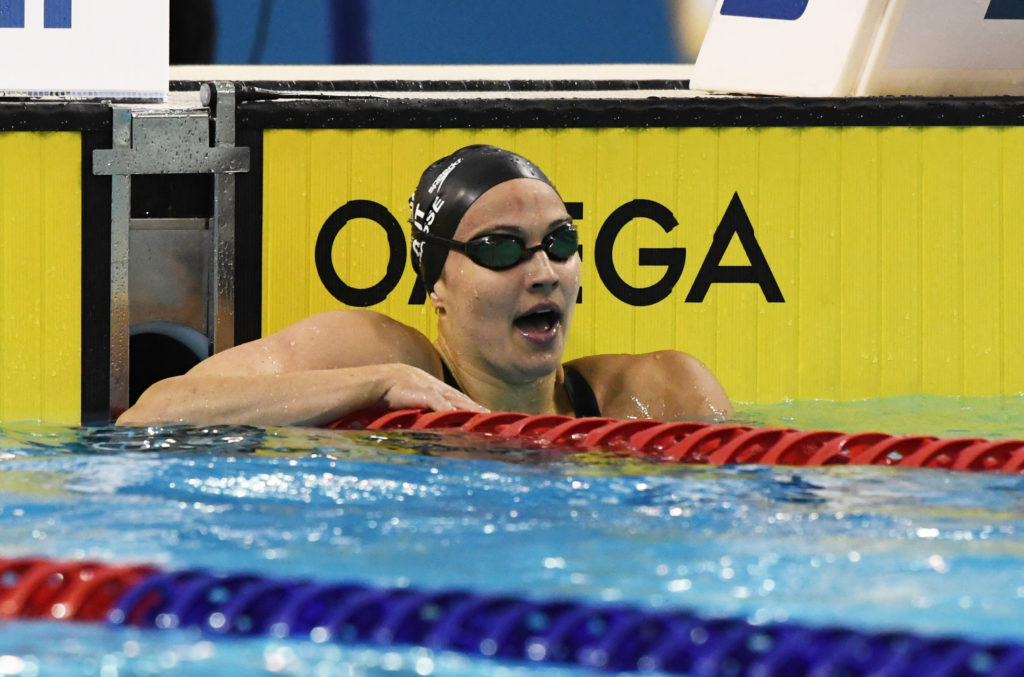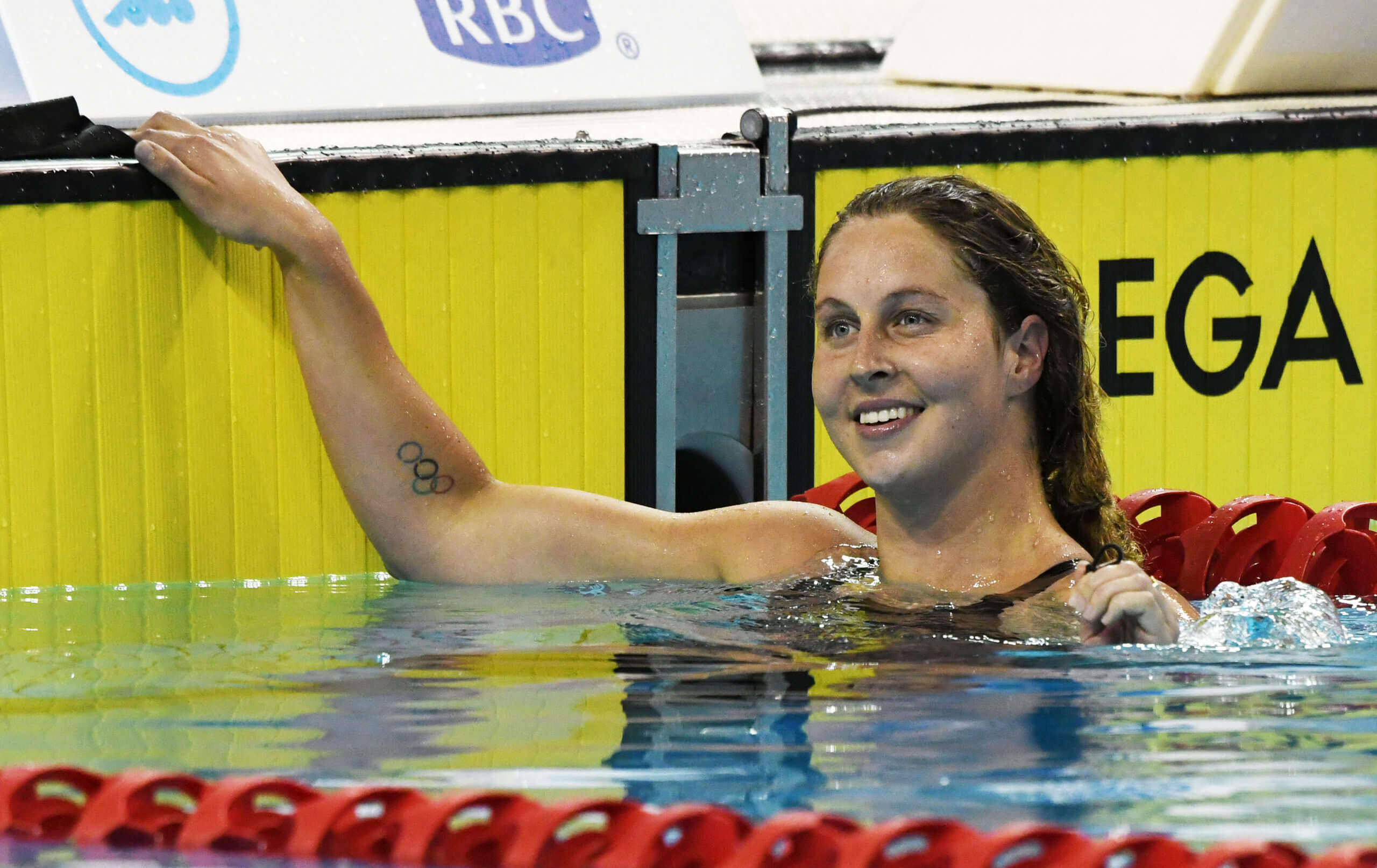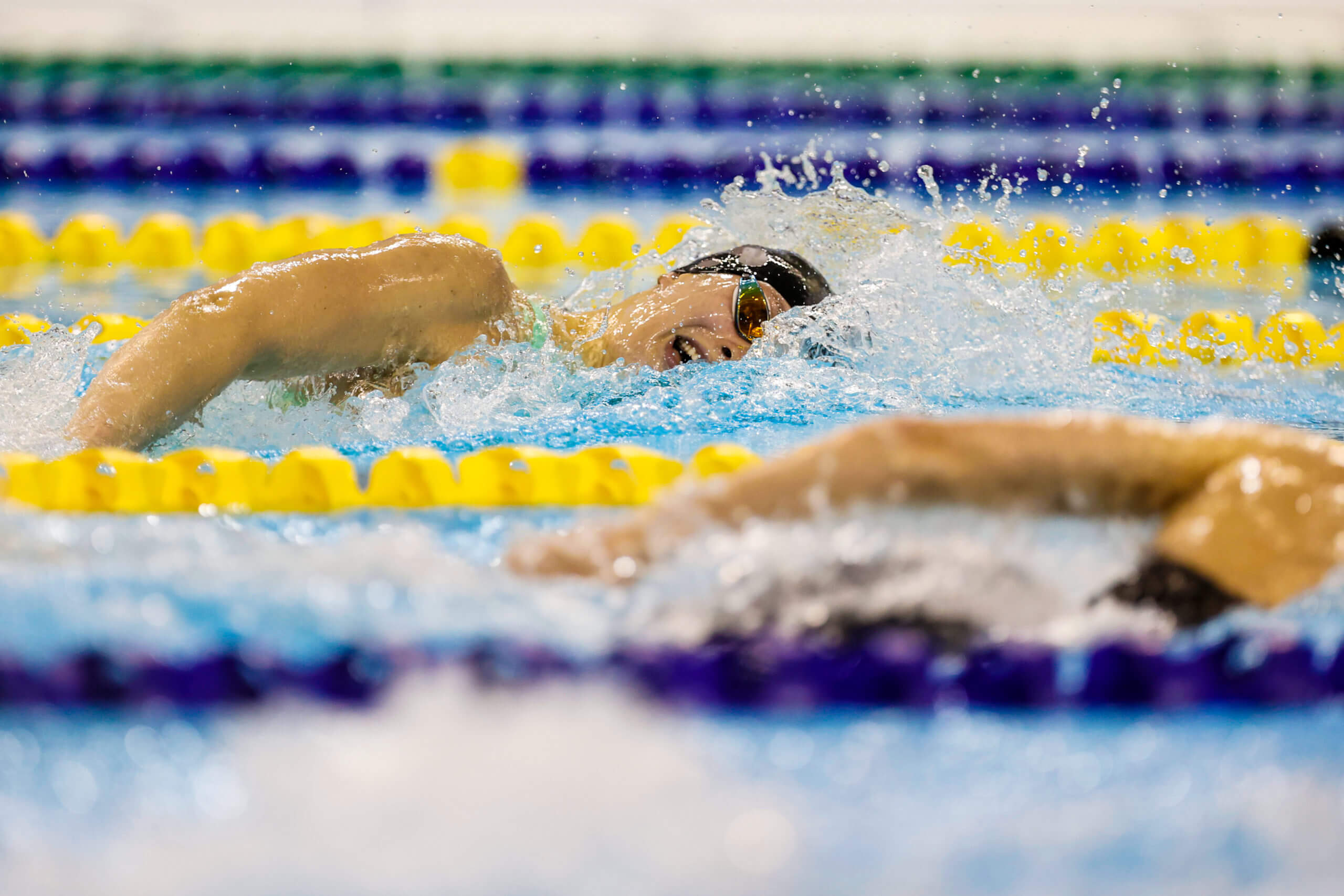For Cohesive Canadian Women’s Swim Team, COVID Disruptions Created Opportunity

Editorial content for the 2021 Tokyo Olympic Games coverage is sponsored by GMX7.
See full event coverage. Follow GMX7 on Instagram at @GMX7training #gmx7

For Cohesive Canadian Women’s Swim Team, COVID Disruptions Created Opportunity
Kylie Masse was still breathing heavily from her race, but the first thing she wanted to talk about was the person in the lane next to her.
It was Night One of the twice-delayed Canadian Olympic Swimming Trials at the Toronto Pan Am Sports Centre in June, and Masse had just done what Masse has done so often over the last Olympic cycle. At 57.70 seconds in the 100 backstroke, she had won Trials in an event she was pre-selected to Tokyo for. She’d lowered her national record by four-tenths of a second and laid down a marker to the other elite backstrokers globally not to forget about her, the two-time reigning world champ and bronze medalist from Rio.

Sydney Pickrem. Photo Courtesy: Scott Grant
But then Masse shifted instantly to Taylor Ruck, her Canadian teammate who booked the second Olympic spot in the event at 59.60.
“I’m so happy for Tay,” Masse said via a Zoom mixed zone (before a brief interruption when she waved off camera to congratulate Cole Pratt for his A cut in the men’s 100 back). “We’ve had the opportunity to train together here for the last year and a half when I joined the centre when pools reopened again. I have so much respect for her and she’s been an amazing training partner who’s pushed me in sets for the last year and a half, and I couldn’t be more happy for her to have made the 100 back and for us to be on this journey together to Tokyo.”
Masse is a naturally magnanimous person, which isn’t breaking news. But her leadership perpetuates a virtuous cycle within Swimming Canada’s ascendant women’s program. Yes, it has benefitted from a historic crop of talent. But the bonds fostered between that elite group have driven them to ever higher heights.
There’s reason to believe that the climb will continue at the Tokyo Olympics.
Out of Crisis, Opportunity
The COVID-19 pandemic presented particular challenges in Canada, which endured a surge in early 2021 that delayed vaccination campaigns and extended lockdowns just as other countries were restoring some degree of normalcy. The restrictions challenged Canadian swimmers, making them one of the last major swimming nations to get back in the pool and conduct trials. But it also presented opportunities.
Swimmers like Masse and Sydney Pickrem, who usually train separate from the High Performance system (in Pickrem’s case, from College Station, Texas, where she starred at A&M) ended up at the Toronto HPC, the first facilities to reopen to the extent that elite swimmers needed. Already a close group of swimmers, they tightened their bonds via a training-camp-type feel even before Trials.
That allowed the leadership of veterans like Masse to extend even further. It’s why Pickrem, who changed not just training bases but countries of residence during the pandemic in pursuing her second Games, lists being around Masse on a daily basis as the biggest change of the last 18 months, even if one is an elite backstroker and the other is a breaststroke/individual medley specialist.
“I think she’s one of my best friends,” Pickrem said during Trials. “She has been outside of the pool for years. Both of us came into this environment because it’s what we had to do to get ready for the Olympic Games. We both have big goals we want to achieve and even though we don’t swim the same things, we push each other day in and day out to pull the standard up. … I’ve been so thankful to have her by my side. Whether it’s all the girls that have kind of done this training before and me and her look at each other and we’re like, that was really hard right? And we’re like, yeah that was hard. …
“Me and Kylie, we have each other’s backs, no matter what, in and out of the pool. And having her and having that new environment to go through it with her has been huge for me this year and I’m excited for both of us. I literally sobbed watching her go 57.7 because I know how much that means to her. And when I wasn’t in a good headspace, she was texting me a gajillion times, and she was like, ‘you’re the baddest here, you’re the best,’ and just hyping me up and behind me 100 percent of the way. So she’s been a huge part of the journey for me for sure.”
Helping the Next Generation
It’s no stretch to extrapolate the connections between established veterans to the biggest story in Canadian camp: The rise of Summer McIntosh. The 14-year-old distance star hails from Etobicoke Swim Club, but she transitioned to the Toronto HPC during the pandemic, as she shed seconds from her times in the distance freestyle events at a feverish pace.

Penny Oleksiak, top, and Summer McIntosh; Photo Courtesy: Michael P. Hall/Swimming Canada
She’s been welcomed like a little sister by swimmers she grew up idolizing. McIntosh took a picture at the 2016 Canadian Trials with Penny Oleksiak, who five years later she beat in the 200 free at Trials. She followed the same pre-Olympics trajectory as Oleksiak, who at age 12 went from her club (Toronto Olympian Swim Club) to the HPC twice a week to train under Ben Titley, on the way to Olympic gold in Rio. A similar conversation, Swimming Canada High Performance Director John Atkinson said last month, occurred in December 2019 between he and the late Kevin Thorburn, then McIntosh’s coach at Etobicoke.
Atkinson, for his part, is keeping the expectations on McIntosh modest in Tokyo, emphasizing the experience rather than the return of hardware.
“What we always do – and we have some great coaches across the country at clubs – is develop that next generation of athletes,” Atkinson said. “It’s a production line that never stops and has to continue developing young athletes. … Summer has arrived on the scene now. She’s a young woman that has done very well, and I think the experience of the Tokyo Games for her is something that she will swim in that environment and learn from it and enjoy the whole experience. Of course she’ll want to do well, but from our perspective, with a young woman of that age and that talent, we’ll work with her that she has a great experience with the team in Tokyo.”
Getting in the talent is step 1, and Canada does it very well. Creating an environment for it to flourish is step 2, and that’s where leaders like Masse, Oleksiak and Pickrem step in. Oleksiak has spoken fondly about training with McIntosh and her “all gas, no brakes” training mentality. Masse speaks about McIntosh with the affection of a little sister.
“Summer is incredible,” Masse said. “She is so sweet and poised and focused and dedicated and hardworking. It obviously shows in her performances, but she’s like that every single day in training. It’s incredible that she’s so young and she’s already achieved this. I don’t even remember what I was doing when I was 14. I’m not sure I was taking swimming seriously at that point. …
“I also think that it’s important moving forward to make sure in our training environment obviously that she’s comfortable, making sure that it’s normal because as her name begins to gets out there and obviously she’s so young, I think it’s important for the older people on the team to keep things as normal as possible because she is younger than a lot of us on the team. I have no doubt that she’ll have an amazing experience in Tokyo, and I can’t wait to see her perform.”
Iron Sharpens Iron
There’s a special alchemy coaches try to achieve in the final weeks before the Olympics. For nations like the United States and (increasingly) Canada, Trials is the hurdle. All but the very, very elite in the nation have to be at top speed at Trials or risk missing out on the Games.
But then comes an exhale, and those that qualify rally together in semi-seclusion (even in non-COVID times) for part two of taper. In that camp, usually in some out-of-the-norm locale, the hope is for swimmers to cohere as a team and produce a whole greater than the sum of its parts.
For the Canadian women, that’s what the last six months of training under COVID-19 restrictions already have been. Save for a handful of names (Kelsey Wog among them), the nucleus the program resides at the Toronto HPC, where Masse, Ruck, Pickrem, Oleksiak, Kayla Sanchez, Maggie MacNeil and others train. It’s not just the out-of-the-pool comfort of having your buddies close but an arrangement that has real consequences in the water.
The collection may have been out of necessity, as other pools limited access during the pandemic. But the hope is that it will pay dividends in Tokyo.
“I think it is the most important thing ever,” Oleksiak said. “I don’t think I would be as fast as I am if didn’t have those girls to train with. They seriously push me in and out of the pool. They are the nicest girls ever. They’re all very open about what they struggle with. They come into the pool every day and they’re smiling and ready to go, and I think just having that atmosphere and having these specific girls, I honestly would not want to train with anyone else, I don’t care who it is.”
“I literally swim with one of the best flyers in the world,” Pickrem said. “I swim with one of the best backstrokers in the world. I swim with probably four of the best freestylers in the world. And so they push me in every little way. … I get pushed in so many different ways and I’m so thankful to be part of this group.”




